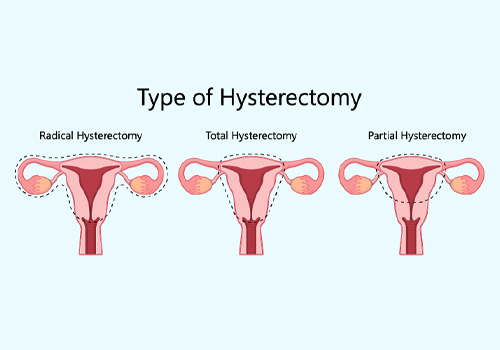
Hysterectomy
A hysterectomy is a surgical procedure to remove the uterus (womb). Depending on the patient’s condition, it may involve removing other structures such as the cervix, ovaries, or fallopian tubes. After this procedure, a woman can no longer conceive or menstruate.
Types of Hysterectomy
-
Based on the Extent of Removal:
- Total Hysterectomy: Removal of the uterus and cervix.
- Subtotal (Partial) Hysterectomy: Removal of the upper part of the uterus, leaving the cervix intact.
- Radical Hysterectomy: Removal of the uterus, cervix, upper part of the vagina, and surrounding tissues (often performed for cancer).
-
Based on the Surgical Approach:
- Abdominal Hysterectomy: Open surgery through a large incision in the abdomen.
- Vaginal Hysterectomy: Performed through the vaginal canal with no external incisions.
- Laparoscopic Hysterectomy: Minimally invasive surgery using small incisions and a laparoscope.
- Robotic-Assisted Hysterectomy: A form of laparoscopic surgery using robotic technology for precision.
Reasons for a Hysterectomy
-
Non-Cancerous Conditions:
- Uterine fibroids causing pain or heavy bleeding.
- Endometriosis or adenomyosis.
- Chronic pelvic pain.
- Uterine prolapse (when the uterus descends into the vagina).
-
Cancerous or Precancerous Conditions:
- Cancer of the uterus, cervix, or ovaries.
- Precancerous changes in the cervix or uterus.
-
Obstetric Emergencies:
- Severe postpartum hemorrhage.
- Uterine rupture.
Procedure and Recovery
-
Pre-Surgery Preparation:
- Comprehensive medical evaluation, including blood tests, imaging (e.g., ultrasound, MRI), and pelvic examination.
- Discontinuation of certain medications (e.g., blood thinners).
- Fasting before surgery as per the surgeon’s instructions.
-
During the Surgery:
- Anesthesia is administered (general or regional).
- The uterus is removed via the chosen surgical approach.
- The incision or surgical site is closed.
-
Post-Surgery Recovery:
- Hospital Stay: 1-5 days depending on the approach.
- Pain Management: Use of prescribed medications.
- Activity Restrictions: Avoid heavy lifting and strenuous activities for 4-8 weeks.
- Follow-Up: Regular check-ups to monitor healing and manage any complications.
Benefits of Hysterectomy
- Relief from chronic pain or heavy bleeding.
- Improvement in quality of life for conditions like fibroids or endometriosis.
- Eliminates the risk of uterine or cervical cancer in preventive cases.
Risks and Complications
-
Short-Term Risks:
- Bleeding, infection, or blood clots.
- Reaction to anesthesia.
-
Long-Term Risks:
- Hormonal changes if the ovaries are removed (leading to surgical menopause).
- Pelvic organ prolapse in some cases.
- Emotional or psychological impact.
Alternatives to Hysterectomy
For women who wish to avoid surgery or preserve fertility, alternatives may include:
- Medications: Hormonal therapy or pain management.
- Minimally Invasive Procedures:
- Uterine artery embolization (for fibroids).
- Endometrial ablation (to reduce bleeding).
- Myomectomy (removal of fibroids without removing the uterus).

